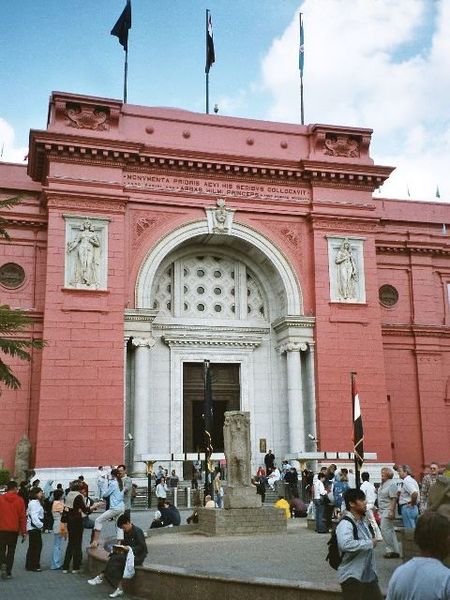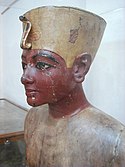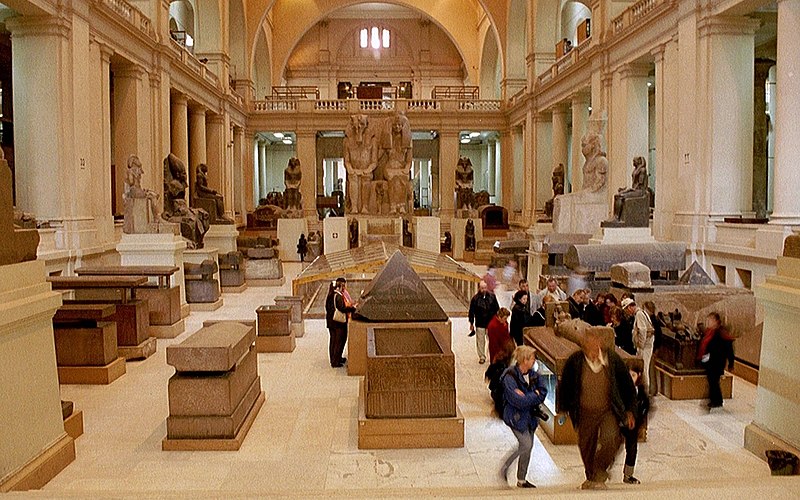Museo Egipcio de El Cairo - Español
De Wikipedia, la enciclopedia libre

El Museo Egipcio de El Cairo o Museo de Antigüedades Egipcias, conocido comúnmente como Museo Egipcio (en idioma árabe|árabe المتحف المصري), se encuentra en El Cairo, y custodia la mayor colección de objetos de la época faraónica del antiguo Egipto; posee más de 120.000 objetos clasificados de diferentes épocas de la historia egipcia: Tinita, Imperio Antiguo, Imperio Medio, Imperio Nuevo, Tercer Período Intermedio, Tardío, Helenístico y Romano, sobresaliendo de otros museos no solo por la cantidad, sino también por la importancia de muchos de ellos. Más de 2 millones y medio de personas visitan el museo anualmente.[1]
Se encuentra en el centro de El Cairo, en la plaza Tahrir () y fue diseñado en 1900 por el arquitecto francés Marcel Dourgnon en estilo neoclásico, inaugurándose en 1902. Lo administra el Consejo Superior de Antigüedades (Supreme Council of Antiquities, SCA), cuyo secretario es Zahi Hawass. Desde 2004 la directora del museo es Wafaa El Saddik, doctorada en arqueología en Viena.
Contenido |
Antecedentes [editar]
En 1835 fue creado el Servicio de Antigüedades de Egipto para proteger los tesoros y monumentos del país de la codicia y expoliación local y extranjera. Esto condujo a que, por primera vez, el gobierno egipcio reuniera una colección de Arte Egipcio, que se guardó al principio en un pequeño edificio del parque Esbekiah de El Cairo, y más tarde fue trasladado a la Ciudadela de Saladino. Pero el gobernador de Egipto, Abbas Pachá, regaló esta colección al emperador austríaco Maximiliano, en su visita de 1855 a Egipto. En 1858 Auguste MarietteServicio de Antigüedades) abrió un nuevo museo en el barrio de Bulaq, a orillas del Nilo, pero quedó inutilizado durante una gran inundación; el gobierno decidió construir un gran museo, y hasta entonces la colección se guardó en el palacio de Ismail Pachá, en Giza.[2] (entonces director del
Evolución del museo [editar]
Desde 1922 el museo experimentó un espectacular crecimiento al ser incrementados sus fondos con el gran tesoro de Tutankamón, de más de tres mil quinientas piezas, descubierto por los ingleses Howard Carter y Lord Carnarvon en la tumba del faraón, en el valle de los Reyes, frente a la antigua Tebas, actual Luxor.
Organización interior [editar]
En la planta baja se encuentra una amplia colección de papiros y monedas utilizadas en el mundo antiguo. Los numerosos papiros son generalmente pequeños fragmentos, debido a su deterioro en los últimos dos milenios. Están escritos en varios idiomas, griego, latín, árabe, egipcio antiguo y en escritura de jeroglíficos. Las monedas son de oro, plata y bronce, y las hay no solo de Egipto, también griegas, romanas, e islámicas, lo que ha ayudado a los historiadores en la investigación del comercio antiguo egipcio.
También en la planta baja hay objetos de los Imperios Antiguo, Medio y Nuevo, e incluyen estatuas, pinturas, y sarcófagos. Entre ellos hay objetos encontrados en las tumbas de varios faraones, así como otros muchos encontrados en el Valle de los Reyes.
En el piso superior se encuentra el tesoro de Tutanjamon y la exposición continúa siguiendo un orden cronológico con objetos de las últimas dinastías, entre ellos los de las dinastías XXIXXII de Tanis, incluida la máscara de oro del faraón Psusennes I. La colección acaba con la muestra de varias piezas del periodo romano, como un mosaico con la cabeza de Medusa.[3] y
Todavía hay un gran número de objetos en el almacén, situado en los sótanos del museo que no se han documentado, incluidos los procedentes de alrededor de 600 tumbas, cuyo inventario tendrá una duración de años.[1]
Contenidos del museo [editar]

En el museo se exhiben objetos de todos los periodos del antiguo Egipto:[2]
- Época predinástica y protodinástica:
- Las vasijas de piedra y objetos funerarios.
- Imperio Antiguo:
- La estatuaria, pinturas, relieves y objetos mobiliarios.
- Imperio Nuevo:
- Periodo Tardío:
- Estatuas, relieves y objetos funerarios
- Época greco-romana:
- Estatuas y objetos funerarios.
En los jardines del museo se exhiben esculturas de varias épocas.
| Algunas piezas del Museo | |||
|---|---|---|---|
 |  |  |  |
| | | | |
 |  |  |  |
| | | | |
 |  |  |  |
| | | | |
Proyectos actuales [editar]
El gobierno egipcio inició una nueva empresa llamada "Proyecto de las Momias Egipcias" que se viene desarrollando desde hace más de dos años. Pues según parece algunas momias están mal identificadas. Gracias a la donación de un escáner móvil por parte de la empresa SiemensNational Geographic, las momias de los antiguos faraones están siendo analizadas. La primera fue la de Tutankhamón, en enero de 2005, con resultados sorprendentes. El objetivo es crear una enorme base de datos con la información tridimensional y el ADN de todas las momias faraónicas que existen tanto en Egipto como en el extranjero. Con ella los investigadores podrán intercambiar datos y opiniones para seguir la pista de reyes perdidos. y al dinero aportado por
Referencias [editar]
Citas [editar]
Fuentes [editar]
- Weidenbach, Thomas (2008). «Die bedeutendste Sammlung der pharaonischen Antike» (en alemán). Quarks & Co. Consultado el 23 de juni de 2009.
- De Dios, Julian (2001). «Museo Egipcio de El Cairo», Egipto. de Dios Editores. ISBN 987-9445-02-3. Consultado el 23 de junio de 2009.
- Bongioanni, Alessandro y Sole Croce, Maria (2003). The treasures of Ancient Egypt from the Egyptian museum in Cairo. Ed. Rizzoli. ISBN 0-7893-0986-6.
Enlaces externos [editar]
 Wikimedia Commons alberga contenido multimedia sobre Museo Egipcio de El Cairo.
Wikimedia Commons alberga contenido multimedia sobre Museo Egipcio de El Cairo.- Página oficial. (en inglés)
- Visita virtual al Museo.
- Vídeo del Museo Egipcio de El Cairo.
- Insecula (Encyclopédie des arts et de l'architecture) (en francés)
- El Proyecto de las Momias Egipcias
##########################################
RSS Feed de Amigos de la Egiptología
http://www.egiptologia.com/index.php?format=feed&TYPE=rss
##########################################
Todo sobre las Pirámides de Egipto
http://www.egiptologia.com/todo-sobre-las-piramides.html
Recomendamos: Instituto de Estudios Arqueológicos Bíblicos
http://www.ieab.net
--------------------------------------------------------------
LISTA DE DISTRIBUCIÓN DE AMIGOS DE LA EGIPTOLOGÍA - AE
Gestión Altas-Bajas y consulta mensajes enviados:
http://www.egiptologia.com/lista-de-distribucion.html
Moderador: Víctor Rivas egiptologia@egiptologia.com
Amigos de la Egiptología: http://www.egiptologia.com
Los mensajes de Amigos de la Egiptología son distribuidos gracias al apoyo y colaboración técnica de RedIRIS Red Académica Española - http://www.rediris.es
Egyptian Museum - Inglés
From Wikipedia, the free encyclopedia
| | This article is written like an advertisement. Please help rewrite this article from a neutral point of view. For blatant advertising that would require a fundamental rewrite to become encyclopedic, use {{db-spam}} to mark for speedy deletion. |
| This article includes a list of references, related reading or external links, but its sources remain unclear because it lacks inline citations. Please improve this article by introducing more precise citations where appropriate. (July 2009) |
The Museum of Egyptian Antiquities, known commonly as the Egyptian Museums, in Cairo, Egypt, is home to an extensive collection of ancient Egyptian antiquities. It has 120,000 items, with a representative amount on display, the remainder in storerooms. Coordinates: 30°2′52″N 31°14′0″E / 30.04778°N 31.233333°E
The museum's Royal Mummy Room, containing 27 royal mummies from pharaonic times, was closed on the orders of President Anwar Sadat in 1981. It was reopened, with a slightly curtailed display of New Kingdom kings and queens in 1985. Today there are about 9 mummies displayed. One of them is the newly discovered mummy of Queen Hatshepsut.
Contents |
[edit] History
The Egyptian Museum of Antiquities contains many important pieces of ancient Egyptian history. It houses the world’s largest collection of Pharaonic antiquities, and many treasures of King Tutankhamen. The Egyptian government established the museum, built in 1835 near the Ezbekeyah Gardens. The museum soon moved to Boulaq in 1858 because the original building was getting to be too small to hold all of the artifacts. In 1855, shortly after the artifacts were moved, Duke Maximilian of Austria was given all of the artifacts. He hired a French architect to design and construct a new museum for the antiquities. The new building was to be constructed on the bank of the Nile River in Boulaq. In 1878, after the museum was completed for some time, it suffered some irreversible damage; a flood of the Nile RiverGiza. The artifacts remained there until 1902 when they were moved, for the last time to the current museum in Tahrir Square. caused the antiquities to be relocated to another museum, in
[edit] Interior design
There are two main floors of the museum, the ground floor and the first floor. On the ground floor there is an extensive collection of papyrus and coins used in the Ancient world. The numerous pieces of papyrus are generally small fragments, due to their decay over the past two millennia. Several languages are found on these pieces, including Greek, Latin, Arabic, and the Ancient Egyptian writing language of hieroglyphs. The coins found on this floor are made of many different elements, including gold, silver, and bronze. The coins are not only Egyptian, but also Greek, Roman, and Islamic, which has helped historians research the history of Ancient Egyptian trade. Also on the ground floor are artifacts from the New Kingdom, the time period between 1550 BC. These artifacts are generally larger than items created in earlier centuries. Those items include statues, tables, and coffins. On the first floor there are artifacts from the final two dynasties of Ancient Egypt, including items from the tombs of the Pharaohs Tuhtmoisis III, Tuhtmosis IV, Amenophis II, Hatshepsut, and Maherpen, and also many artifacts taken from the Valley of the Kings
[edit] King Tutankhamun
Unlike many of the tombs discovered in Egypt, that of King Tutankhamun was found mostly intact. Inside the tomb there is a large collection of artifacts used throughout the King’s life. These artifacts range from a decorated chest, which was most likely used as a closet or suitcase, to ivory and gold bracelets, necklaces, and other decorative jewelry, to alabaster vases and flasks. The tomb is also home to many weapons and instruments used by the King. Although the tomb holds over 3,500 artifacts, it should be noted that this tomb was not found completely intact. In fact, there have been at least two robberies of the tomb, perhaps soon after Tutankhamun's burial. The most well known artifact in King Tutankhamun’s tomb is the famous Gold Mask, which rests over the bandages that wrap around the King’s face. The mask weighs in at 24.5 pounds of solid gold, and is believed to represent what the King’s face really looked like. Many features of the mask the eyes, nose, lips and chin are all represented very well.
[edit] Pharaohs
The remains of many famous Pharaohs are stored in the Egyptian Museum. One of these is Pharaoh Ramses III, who was an extremely skilled warrior. For many of the mummified pharaohs, it has been very difficult to determine when they were born. Also, historians can only estimate a time when they reigned over Egypt. For Amenhotep IV, historians have estimated that he reigned around 1372 B.C. They knew this because they found out when Amenhotep IV's father, Amenhotep III died. Also, that Amenhotep IV's tomb inscribed five names he gave himself and one of them, Golden Horus, proves that he was crowned on the bank of the Nile, his father's favorite domain. Before he even became pharaoh, however, he was already married to Nefertiti. When Amenhotep IV did become pharaoh, he destroyed the religion of Amun. He did this because he wanted start his own new religion of Aten, the disc which sent out rays ending in hands. King Sneferu was believed to be the first king of the Fourth Dynasty. The year Sneferu was believed to have started his reign over Egypt was around 2620 B.C. Sneferu is believed to have been a fair and just king. Master of Justice or Truth was his other chosen name. Sneferu, like many other kings, built many temples and structures. All of Sneferu’s structures and buildings had a signature. His signature was having a statue of a woman symbolizing the foundation. The statue of the young women is presenting the sign of life and votive offerings, as well as the signs of the city and the stronghold. There are about four or five of these in each province. A lot of the pharaohs had coronation names and they all seemed to be alike. For example, Sneferu, Tut, and Amenhotep all had the name "Golden Horus".
[edit] See also
- Egyptian Museum of Turin
- Egyptian Museum of Berlin
- Grand Egyptian Museum
- List of museums with major collections of Egyptian antiquities
[edit] Further reading
- Brier, Bob (1999). The Murder of Tutanhamen: A True Story. ISBN 0425166899.
- Montet, Pierre (1968). Lives of the Pharaohs. World Publishing Company.
- Wafaa El-Saddik. The Egyptian Museum. Museum International. (Vol. 57, No.1-2, 2005).
- Egyptian Treasures from the Egyptian Museum in Cairo, Francesco Tiradritti, editor, Araldo De Luca, photographer. 1999, New York: Abrams ISBN 0810932768. Also published, with variant titles, in Italy and the UK. Reviews US ed.
[edit] External links
| Wikimedia Commons has media related to: Egyptian Museum (Cairo) |
- Egyptian Museum official website
- Egyptian Museum, by Mark T. Rigby
- The Cairo Museum
- Gallery of Items in the Egyptian Museum
- Entry at Insecula (Encyclopédie des arts et de l'architecture) (French)
| |||||||
En otros idiomas
- العربية
- مصرى
- Asturianu
- Català
- Česky
- Deutsch
- English
- Euskara
- فارسی
- Suomi
- Français
- Galego
- עברית
- Magyar
- Italiano
- 日本語
- ქართული
- Nederlands
- Norsk (nynorsk)
- Norsk (bokmål)
- Polski
- Português
- Русский
- Srpskohrvatski / Српскохрватски
- Simple English
- Српски / Srpski
- Svenska
- Türkçe
- Українська
- 中文







No hay comentarios:
Publicar un comentario